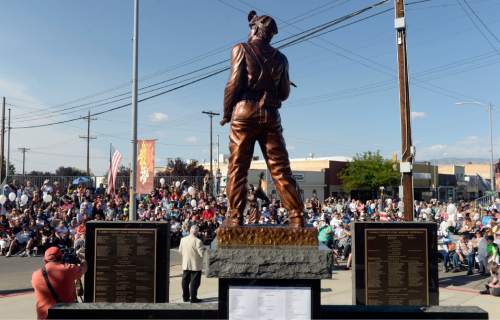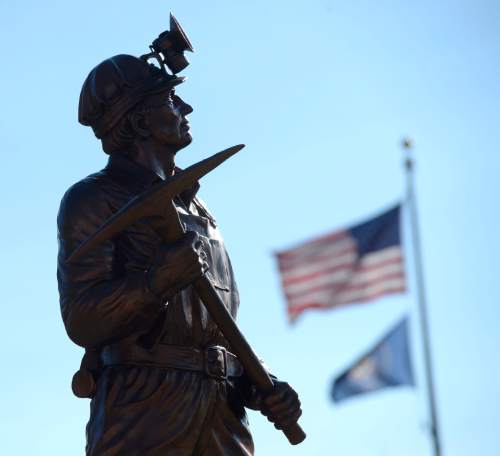This is an archived article that was published on sltrib.com in 2016, and information in the article may be outdated. It is provided only for personal research purposes and may not be reprinted.
Like so many other Southern Slavic people — including Serbs, Croats and Slovenes — hoping to improve their lot, Joe Rebol left the "economically underdeveloped" region of his country in Ribnica, Dolenjska, to work the mills, dams and mines of the American West.
It was 1900. The 15-year- old worked at a steel mill in Pueblo, Colo. Three years later, he landed in Utah's Carbon County.
"My dad and a fellow Slovenian signed up with the U.S. government to build some dams in Utah," Rudy Rebol said in interviews archived at the University of Utah's Marriott Library. "But when they saw workers living in tents they took off and headed to Helper."
According to Rebol, they thought they were catching a train to Colorado.
"Instead," he said, "they got a local to Sunnyside."
Flat broke and homeless, they found lodging at a Slovenian boardinghouse and work opportunities in the Sunnyside mine. Soon after the inexperienced colliers settled in, widespread miners' demands for safer working conditions, pay equity and provoked a 1903 strike. Attempts at conciliation were stymied.
"Recent immigrants from southern and eastern Europe were the important elements in the burgeoning labor movement," historian Allan Kent Powell wrote in "The Next Time We Strike." "In the coal fields of Carbon County, Finnish, Slavic, and Italian miners provided the strength behind Utah's most serious labor confrontation to that time, a confrontation that began in the fall of 1903 and lasted more than a year. Frustrated in their past efforts to unionize, Utah miners found fresh hope in events outside the state."
Returning to Pueblo's steel mills, Joe next moved to Leadville's silver mines where he met and married Slavic immigrant Karoline Andolsek. Realizing he could earn more mining coal, the couple returned to Carbon County — and never left.
For years, Joe worked in various mines, was a member of the Western Slavonic Association that aided disabled mineworkers, widows and children, and was a member of the National Miners Union (NMU).
The Rebol children attended school in Castle Gate, Hiawatha, Price and Helper. Karoline opened her home to lodgers. "She always had four boarders at a time in those days," Rebol said. Saving every extra nickel, dime and dollar, Joe bought a 1916 Buick touring car from the Utah-Idaho Motor Co. for $300.
"A beautiful car, it was the fourth one in Castle Gate," Rebol recalled. "The superintendent, mine foreman and doctor had the other three."
But mining was dangerous work. Explosions occurred. People died or were maimed. Women became widows; children became orphans, and it seemed a miner's lot hinged on negotiating with management.
In the 1922 Carbon County strike, a striker and deputy sheriff were killed. More people were wounded. Families evicted from company homes were forced to spend the winter in tent communities.
"Strikebreakers brought in by train were shot at by strikers," Rebol said. "It was at its worst when we started seeing Ku Klux Klan cross burnings and late night marches."
During prohibition, Joe, was turned in for having a meat smokehouse. "The revenue agents thought there was an underground still, but that was just a plain old smokehouse," Rebol said.
Throughout the Great Depression, workers were laid off, mines opened randomly, shifts were short, mental health took a devastating hit and everyone went hungry.
Attempting to help, the NMU and United Mine Workers of America were at loggerheads with one another. In the September 1933 strike, members of the National Guard "discharged tear gas toward" 400 miners and women marching down Main Street. NMU organizer Charley Guynn was jailed. Joe got him out on bail, but was blackballed for nine months for his effort.
Hired as a trackman at Castle Gate on July 1, 1934, 49-year- old Joe Rebol, tall and seemingly fit, suffered a debilitating stroke three days later, on July 4, and never returned to the strikes, or the mines.
Eileen Hallet Stone, author of "Hidden History of Utah," and "Historic Tales of Utah," a new compilation of her "Living History" columns in the Salt Lake Tribune, may be reached at ehswriter@aol.com. Special thanks to Carol Lupus and University of Utah Marriott Library Special Collections.









